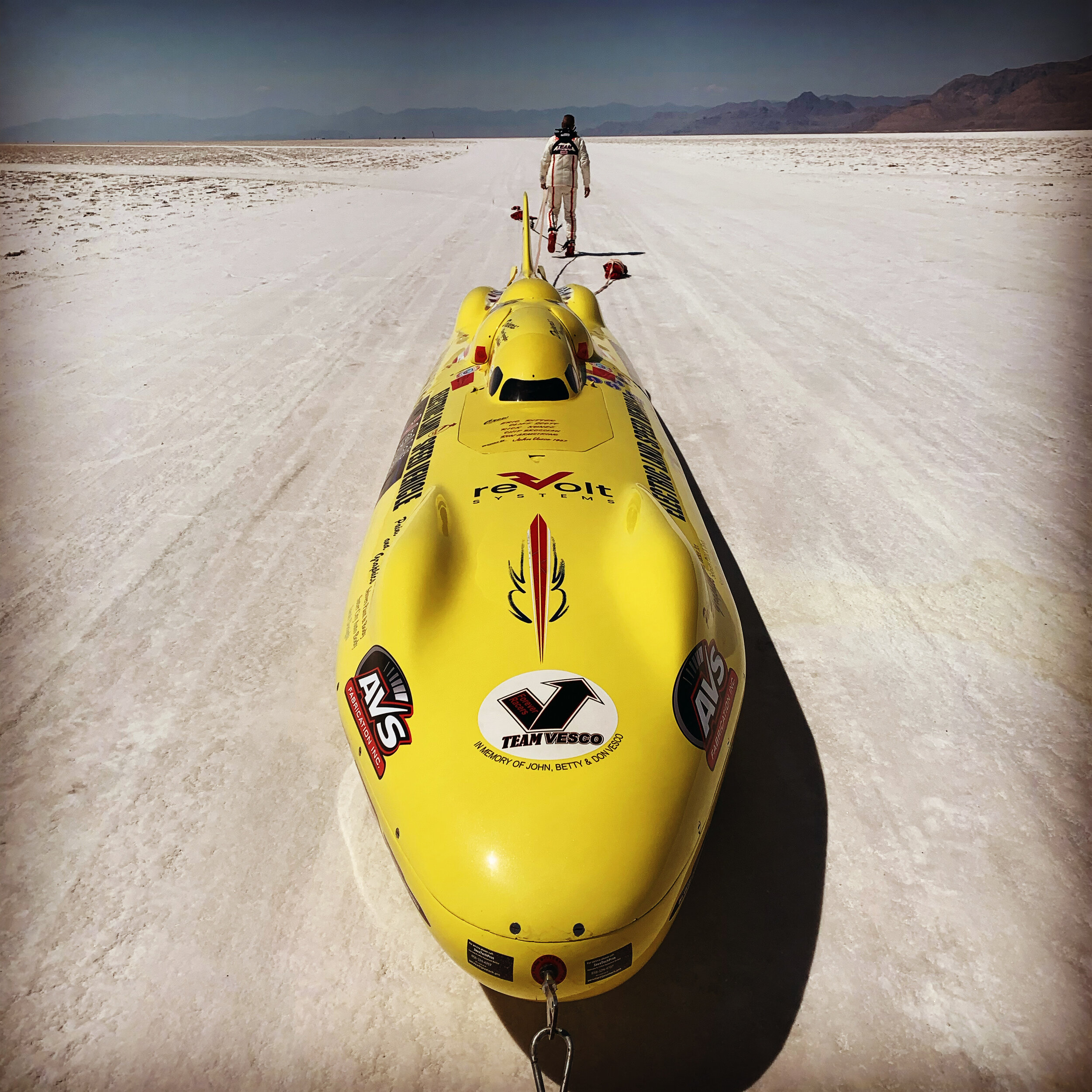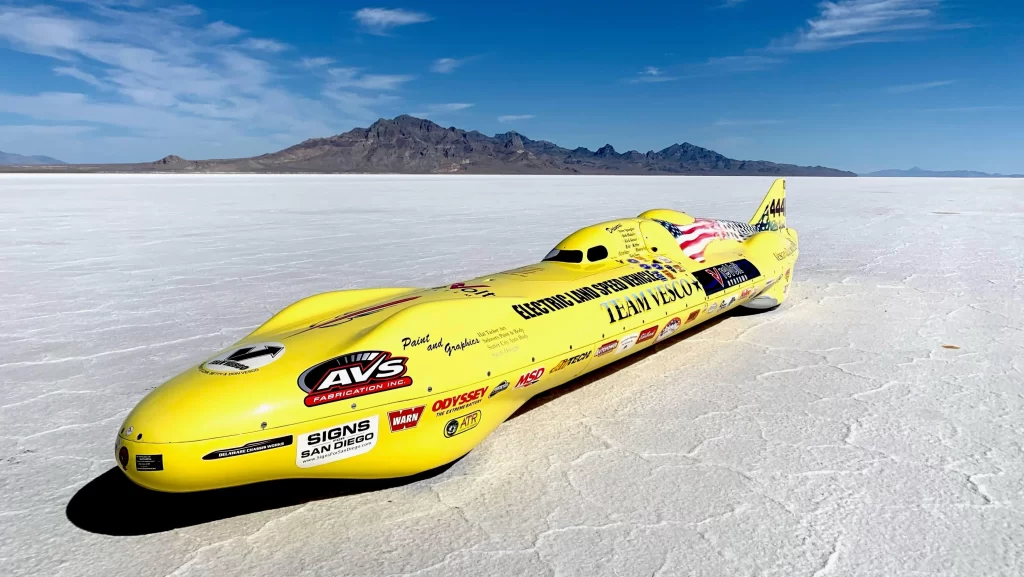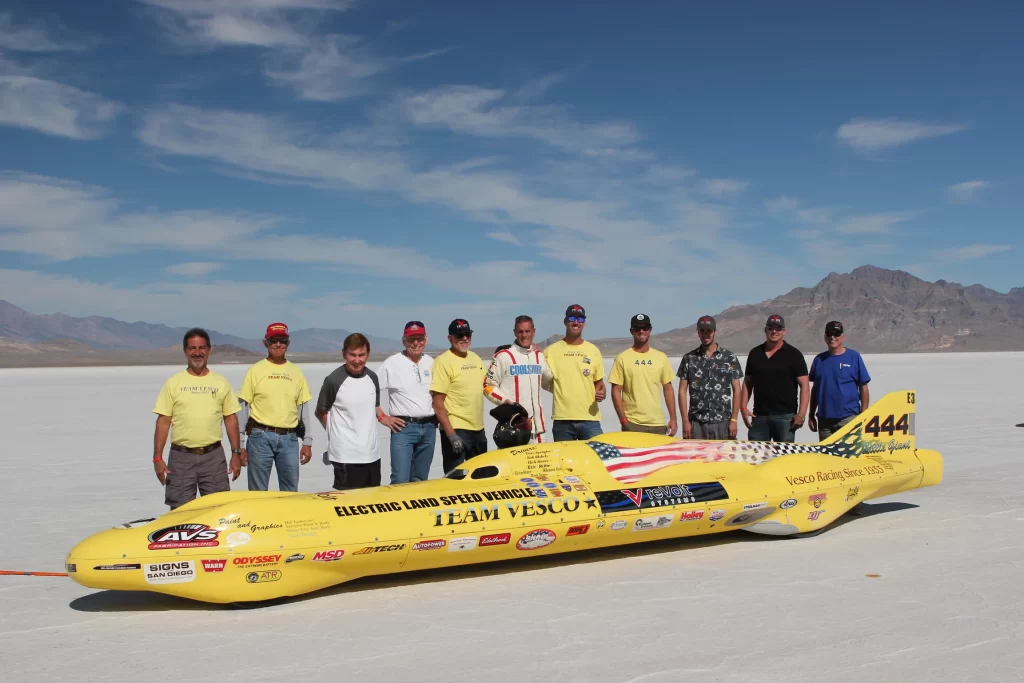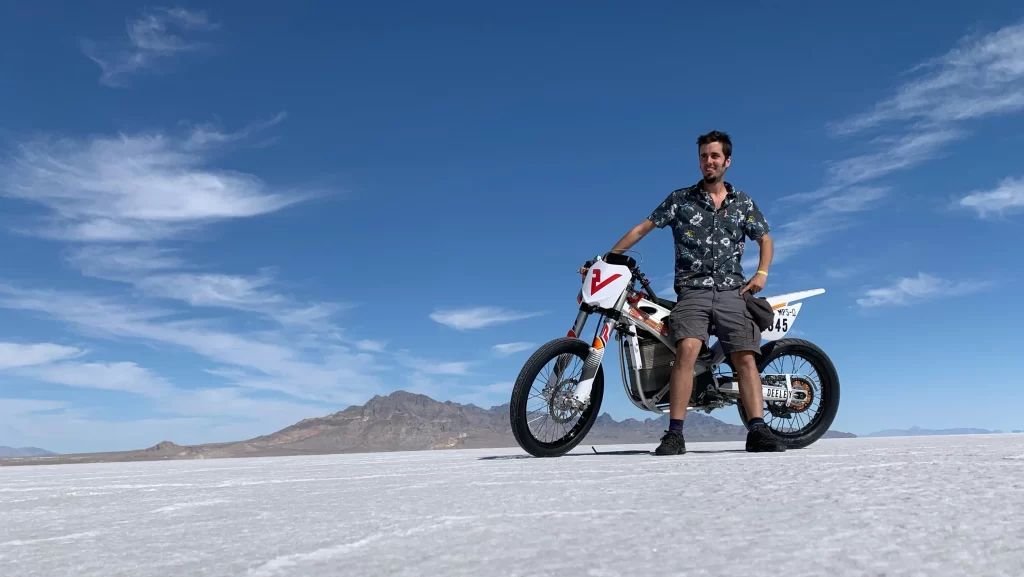Here’s How The Revolt Systems Streamliner Set The Electric Land Speed Record At Bonneville

The team ran 357 miles per hour to become the fastest EV in the world.
Published on Jalopnik on Oct. 5, 2021

The world of electric hot rodding is hotter than it has ever been. I know I say this a lot, but it feels like the 1950s all over again, with speed freaks stealing motors out of big luxury sedans and stuffing them into streamliners and going really frickin’ fast. As Everyday Joes continue to figure out what makes electric propulsion tick, these machines are only going to get quicker, faster, and better. This week that case is made ever more clear by the fact that a Eddy Borysewicz and a few of his friends put together a volunteer effort to build the fastest electric car in the world.
To figure out exactly how this whole project went down, I called Eddy to get the lowdown. As it turns out, Eddy got salt fever a few years ago when an old friend of his invited him out to Bonneville. That friend was David Spangler, driver of the 500-mile-per-hour Turbinator. Keep interesting company, I always say. In 2020 Eddy worked with EV West on the Electraliner effort, which broke an electric class record easily. Getting a car into the 200s proved relatively easy, but breaking into the 300s and beyond proved a little more of a challenge.
Since his time with EV West, Borysewicz has since broken off to start his own EV swap company called Revolt Systems. And Bonneville never left his heart. Spangler put Eddy together with the Team Vesco folks, who field the world-dominating Turbinator turbine car. As luck would have it, the team had a second streamliner kicking around which could use an injection of electrified horsepower.
The car in question was The Little Giant #444. This car was originally put to paper back in 1957, and has been racing basically non-stop since it was built in 1958. Of course over the years lots of the car’s systems have been updated and changed and rebuilt, so there isn’t much 1958 technology left in it, but it makes a good story. For decades the car has been raced with a variety of different internal combustion engines in it, and even held some records in its time. Both Vesco and Revolt had the SCTA record in sight when they decided to work together.
Ohio State University took the outright EV record way back in October of 2004 with the original Buckeye Bullet, setting a top speed of 314.95 miles per hour in a flying mile, and it went on to set the FIA record for electric vehicles with a 341.26 mile per hour run over the flying kilometer. The team knew it could aim for the SCTA record, but wasn’t positive if the world record was on the table. Nothing to it but to do it.
A deal was struck in May of this year, and the car had to be ready to go by August for Bonneville Speed Week. That’s a pretty quick turnaround, but they made it and the car was ready to roll about a week before the big show. A few issues immediately presented themselves. Because this was originally an internal-combustion car, and modifying the structure of the car was a non-starter, the team had to fit a pair of Tesla motors and all of the batteries within existing holes, where the motor, transmission, and fuel tank of the gas-powered drivetrains would have gone before.

Revolt’s business model is taking Tesla motors and making them longitudinal for motor swaps. The team developed a new layout for The Little Giant which would house two Tesla Model S large drive units joined together. The bottom motor is connected directly to the quick change rear end with a shorty 4-inch driveshaft. The top motor is belted to its twin using a Gates 6-inch wide carbon industrial purpose belt, which looks more or less like a big supercharger belt. According to Eddy, it’s ‘bomb-proof’.
For Speed Week in August they couldn’t source enough of the batteries they really wanted to use, and were forced to stuff a Tesla P100 pack into the car. They were pretty sure from the off that the pack wouldn’t produce the amperage and voltage that the car needed to run with the full beans. In August the team could never seem to reach the 300 mile per hour barrier, and knew that it wouldn’t come close to the record. They used that run as a shakedown opportunity, logging a whole bunch of data, getting their driver and car qualified to run the long course, and figuring out a few cooling things. From that first run, the plan was to return in late September for World Finals.
In the time from mid-August to late September, the team built a new battery pack by hand from the prismatic cells cribbed from a Ford CMax Energi plug-in hybrid. These are something of a dark secret in the EV hot rodding scene, as they are super potent, but somewhat hard to get a hold of. But the car was back together and ready to go with a few days before needing to take off for Bonneville again.
On the first run the car was immediately and visibly much faster. On September 30th the car shot away from the start and tripped the timing beams at 328.020 miles per hour, well in excess of the Buckeye Bullet record. The new batteries were working just as Borysewicz had planned. Run one done, the team went back out to back up their record and set a conservative 316.442 mph. The SCTA record was theirs with a two-run average of 322.231 miles per hour.
What Revolt hadn’t told anyone, however, was that they were running an extremely conservative power curve on their Tesla motors. Not only had they already scored the record in convincing fashion, they had more in the tank! Eddy looked at the team on the morning of October 1st and said “What do you guys want to do? You want to turn it up?”
As it turns out, there was a lot left in the motors and batteries, but it proved a lot to deal with for a lot of the ancillary components. The power was so potent that the car’s maintenance switch blew in the middle of mile three, and the car coasted down dead stick. It had run 350.234 miles per hour without power. With that problem fixed, it was time for another backup run, and again a fuse blew in the third mile and the car coasted down to a 357.507 mile per hour run. Average those two runs out to 353.870 mph and you’re looking at the official fastest EV in the world.
Here, watch the onboard, it’s wild.
As it happens, the current record for electric motorcycles was embarrassingly low, so the team put different tires, lower bars, and a faster sprocket set on an otherwise stock Alta Redshift. So in addition to taking the outright four-wheel electric record, Revolt now has two different SCTA class records for electric motorcycles as well! The Motorcycle Omega class record has been bumped up to 109.406 mph. The team installed the Alta’s factory fork guards and number plate to push the Motorcycle Partial Streamliner Omega class record to 112.719. The bike apparently could have run faster, but the tires weren’t rated for anything more.

It’s amazing to see not only how quickly EV speed is building, but that a relatively small team of just a few enthusiastic engineers can totally smoke a University engineering program with seriously high budgets. The team learned a lot in the process, and has a ton of new data to pour over for the next time. If Team Vesco is interested in continuing the program with The Little Giant into the future, there are bigger and bigger speeds to chase with EV power. And don’t think the competition will end there, because EV West is aiming even higher with its electric rocket, and there are others waiting in the wings to take down the new champ of electric speed. I don’t think it’ll be 17 years before this record is broken.